Facile Reversible Eu2+/Eu3+ Redox in Y2SiO5 via Spark Plasma Sintering: Dwell Time-Dependent Luminescence Tuning
Abstract
1. Introduction
2. Results and Discussion
2.1. Structural Evolution
2.2. SPS
2.3. Luminescent Properties
2.3.1. Sol–Gel Derived Y2SiO5: Eu3+ Powders
2.3.2. SPS-Sintered Y2SiO5: Eu3+—Excitation Spectra
2.3.3. Eu3+ ⟶ Eu2+ Reduction Process
2.3.4. SPS-Sintered Y2SiO5: Eu3+—Emission Spectra
| Site | Coordination Number | Bond | Bond Length/Å [67] | λ/nm | Energy/eV |
|---|---|---|---|---|---|
| Y1 | 7 | Y-O | 0.2239 | 598.66 | 2.07 |
| Y-O | 0.2367 | 587.32 | 2.11 | ||
| Y-SiO4 | 0.2379 | 400.34 | 3.10 | ||
| Y-SiO4 | 0.2589 | 388.71 | 3.19 | ||
| Y-SiO4 | 0.3290 | 359.69 | 3.45 | ||
| Y-SiO4 | 0.2329 | 403.37 | 3.07 | ||
| Y-SiO4 | 0.2337 | 402.88 | 3.08 | ||
| Y2 | 6 | Y-O | 0.2209 | 632.83 | 1.96 |
| Y-O | 0.2325 | 622.42 | 1.99 | ||
| Y-SiO4 | 0.2392 | 422.47 | 2.94 | ||
| Y-SiO4 | 0.2296 | 428.93 | 2.89 | ||
| Y-SiO4 | 0.2358 | 424.71 | 2.92 | ||
| Y-SiO4 | 0.2394 | 422.34 | 2.94 |
2.3.5. SPS-Sintered Y2SiO5: Eu3+—Lifetime Studies
2.3.6. SPS-Sintered Y2SiO5: Eu3+—CIE Coordinates
2.3.7. Oxidation Process of SPS-Sintered Y2SiO5: Eu3—Luminiscent Properties
3. Materials and Methods
3.1. Y2SiO5 Powders Preparation
3.2. Y2SiO5: Eu3+ Sintering and Later Annealing
3.3. Characterisation
4. Conclusions
Author Contributions
Funding
Institutional Review Board Statement
Informed Consent Statement
Data Availability Statement
Acknowledgments
Conflicts of Interest
References
- Farooq, M.; Rafiq, H.; Shah, A.U.I.; Rasool, M.H. Review—On the Development of Phosphors for Luminescent Materials: Synthesis, Characterization, Applications and Evolution of Phosphors as White-Light-Emitting Diodes. ECS J. Solid. State Sci. Technol. 2023, 12, 126002. [Google Scholar] [CrossRef]
- Singh, S.; Singh, D.; Siwach, P.; Gupta, I.; Kumar, P. Synthesis Strategies for Rare Earth Activated Inorganic Phosphors: A Mini Review. Appl. Res. 2025, 4, e202400190. [Google Scholar] [CrossRef]
- Bai, G.; Tsang, M.K.; Hao, J. Tuning the luminescence of phosphors: Beyond conventional chemical method. Adv. Opt. Mater. 2015, 3, 431–462. [Google Scholar] [CrossRef]
- Liang, L.; Yang, H.; Mao, Q.; Zhao, F.; Ding, Y.; Li, X.; Liu, M.; Zhong, J. Eu3+ doping induces asynchronous tuning of luminescence and afterglow in self-activated LiZnSbO4 host for multiple applications. Chem. Eng. J. 2025, 508, 161129. [Google Scholar] [CrossRef]
- Otsuka, T.; Oka, R.; Cicconi, M.R.; de Ligny, D.; Hayakawa, T. Tuning the luminescence color of Eu3+- and alkali-ion-codoped Sr2CaWO6 orange-red phosphors: Eu3+ site distribution and site-selective photoluminescence studies. APL Mater. 2024, 12, 031129. [Google Scholar] [CrossRef]
- Lohe, P.P.; Nandanwar, D.V.; Belsare, P.D.; Moharil, S.V. Colour tuning of garnet phosphor through codoping. J. Lumin. 2021, 235, 118017. [Google Scholar] [CrossRef]
- Chen, W.; Yi, J.; Yuan, H.; Li, L.; Sun, F. Synthesis and tunable luminescence of Eu3+ and Eu2+ codoped LaSr2AlO5:Eu phosphors for LED application. Mater. Today Commun. 2017, 13, 290–294. [Google Scholar] [CrossRef]
- Le, F.; Wang, L.; Jia, W.; Jia, D.; Bao, S. Synthesis and photoluminescence of Eu2+ by co-doping Eu3+ and Cl- in Sr2P2O7 under air atmosphere. J. Alloys Compd. 2012, 512, 323–327. [Google Scholar] [CrossRef]
- Peng, M.; Hong, G. Reduction from Eu3+ to Eu2+ in BaAl2O4:Eu phosphor prepared in an oxidizing atmosphere and luminescent properties of BaAl2O4:Eu. J. Lumin. 2007, 127, 735–740. [Google Scholar] [CrossRef]
- Gonçalves, R.R.; Messaddeq, Y.; Atik, M.; Ribeiro, S.J.L. Optical properties of ZrO2, SiO2 and TiO2-SiO2 xerogels and coatings doped with Eu3+ and Eu2+. Mater. Res. 1999, 2, 11–15. [Google Scholar] [CrossRef]
- Wu, H.; Xu, M.; Chang, C. Modulating the valence of Eu2+/Eu3+ in Sr2MgSi2O7 for white luminescence. J. Alloys Compd. 2024, 1002, 175430. [Google Scholar] [CrossRef]
- Khan, S.; Zheng, H.-W.; Jiao, H.; Saleem, S.; Gul, Z.; Al-Humaidi, J.Y.; Al Bahir, A.; Althomali, R.H.; Ali, A.; Rahman, M.M. Reduction mechanism and energy transfer between Eu3+ and Eu2+ in Eu-doped materials synthesized in air atmosphere. Rev. Inorg. Chem. 2024, 44, 547–567. [Google Scholar] [CrossRef]
- Barbosa, W.T.; Álvarez-Docio, C.M.; Garcia-Carrodeguas, R.; Fook, M.V.L.; Rodríguez, M.A.; Rojas-Hernandez, R.E. Impact of fuel quantity on luminescence properties of Sr3Al2O6:Eu by combustion synthesis. Ceramica 2023, 69, 17–22. [Google Scholar] [CrossRef]
- Dereń, P.J.; Stefańska, D.; Ptak, M.; Wiśniewski, P. Method to Measure the Degree of Reduction of Eu3+to Eu2+: How Anion and Cation Vacancies Influence the Degree of Reduction. J. Phys. Chem. C 2021, 125, 24505–24514. [Google Scholar] [CrossRef]
- Dai, W.B. Mechanism of the reduction and energy transfer between Eu2+ and Eu3+ in Eu-doped CaAl2Si2O8 materials prepared in air. J. Mater. Chem. C Mater. 2014, 2, 3951–3959. [Google Scholar] [CrossRef]
- Lee, J.H.; Singh, S.P.; Kim, M.; Pyo, M.; Park, W.B.; Sohn, K.-S. A rate equation model for the energy transfer mechanism of a novel multi-color-emissive phosphor, Ca1.624Sr0.376Si5O3N6:Eu2+. Inorg. Chem. Front. 2019, 6, 3493–3500. [Google Scholar] [CrossRef]
- Yao, H.; Qiu, Z.; Xiong, X. Preparation and luminescence properties of Ba2Mg(BO3)2:Eu2+/3+phosphor. IOP Conf. Ser. Earth Environ. Sci. 2021, 714, 022019. [Google Scholar] [CrossRef]
- Arman, M.Ö.; Geboes, B.; Van Hecke, K.; Binnemans, K.; Cardinaels, T. Kinetics of electrochemical Eu3+ to Eu2+ reduction in aqueous media. Electrochim Acta 2024, 484, 144055. [Google Scholar] [CrossRef]
- Kusaba, M.; Nakashima, N.; Kawamura, W.; Izawa, Y.; Yamanaka, C. Higher yield of photoreduction from Eu3+ to Eu2+ with shorter wavelength irradiation. Chem. Phys. Lett. 1992, 197, 136–140. [Google Scholar] [CrossRef]
- Ishida, A.; Takamuku, S. One-electron reduction of Eu3+ ions induced by the irradiation of γ-ray or UV-light. The fluorescence properties of Eu2+ ions in an ethanol matrix. Chem. Lett. 1988, 17, 1497–1500. [Google Scholar] [CrossRef]
- Muralidharan, J.H.E.S. Kinetics and mechanism of the oxidation of europium (II) ions and of the reduction of europium (III) ions by 2-hydroxy-2-propyl radicals. Inorg. Chem. 1984, 23, 636–639. [Google Scholar] [CrossRef]
- Zhang, J.C.; Long, Y.Z.; Di Zhang, H.; Sun, B.; Han, W.P.; Sun, X.Y. Eu2+/Eu3+-emission-ratio-tunable CaZr(PO4)2:Eu phosphors synthesized in air atmosphere for potential white light-emitting deep UV LEDs. J. Mater. Chem. C Mater. 2014, 2, 312–318. [Google Scholar] [CrossRef]
- Cui, J.; Wen, Y.; Chen, R.; Cheng, X.; Yu, M.; Liu, J.; Hu, Z.; He, J.; Xiao, Z.; Sun, X.-Y. Bright cyan emission from Eu-Doped borosilicate glasses by optimizing reduction of Eu3+ to Eu2+ in ambient atmosphere. Chem. Eng. J. 2024, 489, 151416. [Google Scholar] [CrossRef]
- Palaspagar, R.S.; Gawande, A.B.; Sonekar, R.P.; Omanwar, S.K. Eu3+→Eu2+ reduction in BaAl2B2O7 phosphor in oxidizing environment. Optik 2015, 126, 5030–5032. [Google Scholar] [CrossRef]
- Singh, D.K.; Iyer, P.K.; Giri, P.K. Role of molecular interactions and structural defects in the efficient fluorescence quenching by carbon nanotubes. Carbon. N. Y 2012, 50, 4495–4505. [Google Scholar] [CrossRef]
- Boukerika, A.; Guerbous, L. Annealing effects on structural and luminescence properties of red Eu3+-doped Y2O3 nanophosphors prepared by sol-gel method. J. Lumin. 2014, 145, 148–153. [Google Scholar] [CrossRef]
- Liu, F.W.; Hsu, C.H.; Chen, F.S.; Lu, C.H. Microwave-assisted solvothermal preparation and photoluminescence properties of Y2O3:Eu3+ phosphors. Ceram. Int. 2012, 38, 1577–1584. [Google Scholar] [CrossRef]
- He, M.; Jia, J.; Zhao, J.; Qiao, X.; Du, J.; Fan, X. Glass-ceramic phosphors for solid state lighting: A review. Ceram. Int. 2021, 47, 2963–2980. [Google Scholar] [CrossRef]
- Lin, Y.C.; Karlsson, M.; Bettinelli, M. Inorganic phosphor materials for lighting. Top. Curr. Chem. 2016, 374, 374–421. [Google Scholar] [CrossRef]
- Sinha, K.; Pearson, B.; Casolco, S.R.; Garay, J.E.; Graeve, O.A. Synthesis and consolidation of BaAl2Si2O8:Eu: Development of an integrated process for luminescent smart ceramic materials. J. Am. Ceram. Soc. 2009, 92, 2504–2511. [Google Scholar] [CrossRef]
- Casolco, S.R.; Xu, J.; Garay, J.E. Transparent/translucent polycrystalline nanostructured yttria stabilized zirconia with varying colors. Scr. Mater. 2008, 58, 516–519. [Google Scholar] [CrossRef]
- Li, J.; Li, S.; Alim, M.A. The effect of reducing atmosphere on the SrTiO3 based varistor-capacitor materials. J. Mater. Sci. Mater. Electron. 2006, 17, 503–508. [Google Scholar] [CrossRef]
- Peng, M.; Pei, Z.; Hong, G.; Su, Q. The reduction of Eu3+ to Eu2+ in BaMgSiO4:Eu prepared in air and the luminescence of BaMgSiO4:Eu2+ phosphor. J. Mater. Chem. 2003, 13, 1202–1205. [Google Scholar] [CrossRef]
- Wang, H.; Su, K.; Mei, L.; Guo, Q.; Liao, L. Vacancy-Enhanced Self-Reduction of Eu in Pyrophosphate Phosphor. Inorg. Chem. 2023, 62, 12468–12479. [Google Scholar] [CrossRef] [PubMed]
- Carreón, J.A.F.; Ocaña, M.; García-Sevillano, J.; Cantelar, E.; Becerro, A.I. New single-phase, white-light-emitting phosphors based on δ-Gd2Si2O7 for solid state lighting. J. Phys. Chem. C 2014, 118, 18035–18043. [Google Scholar] [CrossRef]
- Gonzalez-Ortega, J.A.; Perea, N.; Hirata, G.A. White light emission from Y2SiO5:Ce, Tb films excited by electroluminescence. Opt. Mater. 2006, 29, 47–50. [Google Scholar] [CrossRef]
- Flores, D.L.; Gutierrez, E.; Cervantes, D.; Chacon, M.; Hirata, G. White-light emission from Y2SiO5:Ce3+, Tb3+ and Sr2Si5N8:Eu2+ phosphor blends: A predictive model. Micro Nano Lett. 2017, 12, 500–504. [Google Scholar] [CrossRef]
- Al-Hunaishi, S.; Blin, A.; Harada, N.; Perrin, P.; Goldner, P.; Serrano, D.; Tallaire, A. Rare-earth doped yttrium silicate (Y2SiO5) thin films grown by chemical vapour deposition for quantum technologies. J. Lumin. 2024, 271, 120595. [Google Scholar] [CrossRef]
- Aitasalo, T.; Hölsä, J.; Lastusaari, M.; Niittykoski, J.; Pellé, F. Delayed luminescence of Ce3+ doped X1 form of Y2SiO5. Opt. Mater. 2005, 27, 1511–1515. [Google Scholar] [CrossRef]
- Hamroun, M.S.E.; Guerbous, L.; Bensafi, A. Luminescent spectroscopy and structural properties of Ce3+-doped low-temperature X1–Y2SiO5 material prepared by polymer-assisted sol–gel method. Appl. Phys. A Mater. Sci. Process 2016, 122, 321. [Google Scholar] [CrossRef]
- Martínez, A.A.; Arroyo-Murillo, R.; Korthout, K.; Poelman, D. Reduction of Eu3+ to Eu2+ in α-Y2Si2O7 and X1-Y2SiO5 and their luminescent properties. J. Alloys Compd. 2018, 765, 747–752. [Google Scholar] [CrossRef]
- Hamroun, M.S.E.; Guenanou, A.; Guerbous, L.; Chebout, R.; Bachari, K. Annealing Temperature Effect on Structural and Luminescence Spectroscopy of Y2SiO5:Ce3+ Nanomaterial Synthesized by Sol–Gel Method. J. Res. Updates Polym. Sci. 2022, 11, 54–60. [Google Scholar] [CrossRef]
- Rafiaei, S.M.; Shokouhimehr, M. Structural and optical characterizations of Ce3+-doped YSO phosphors via the addition of TEOS. Luminescence 2021, 36, 1117–1123. [Google Scholar] [CrossRef]
- Sun, Z.; Li, M.; Zhou, Y. Thermal properties of single-phase Y2SiO5. J. Eur. Ceram. Soc. 2009, 29, 551–557. [Google Scholar] [CrossRef]
- Khan, Z.S.; Ali, A.; Nazir, Z.; Cao, X. Effect of calcination temperature on the degree of polymorphic transformation in Y2SiO5 nanopowders synthesized by sol–gel method. J. Non-Cryst. Solids 2016, 432, 540–544. [Google Scholar] [CrossRef]
- Parker, C.G.; Opila, E.J. Stability of the Y2O3–SiO2 system in high-temperature, high-velocity water vapor. J. Am. Ceram. Soc. 2020, 103, 2715–2726. [Google Scholar] [CrossRef]
- Sekulić, M.; Dramićanin, T.; Ćirić, A.; Far, L.Ð.; Dramićanin, M.D.; Ðordević, V. Photoluminescence of the Eu3+-Activated Yx Lu1−x NbO4 (x = 0, 0.25, 0.5, 0.75, 1) Solid-Solution Phosphors. Crystals 2022, 12, 427. [Google Scholar] [CrossRef]
- Manasa, P.; Jayasankar, C.K. Luminescence and phonon side band analysis of Eu3+-doped lead fluorosilicate glasses. Opt. Mater. 2016, 62, 139–145. [Google Scholar] [CrossRef]
- Ramírez, A.d.J.M.; Murillo, A.G.; Romo, F.d.J.C.; Hernández, M.G.; Vigueras, D.J.; Chaderyron, G.; Boyer, D. Properties of Gd2O3:Eu3+, Tb3+nanopowders obtained by sol-gel process. Mater. Res. Bull. 2010, 45, 40–45. [Google Scholar] [CrossRef]
- Gruzintsev, A.N.; Emel’chenko, G.A.; Yermolayeva, Y.V.; Masalov, V.M.; Tolmachev, A.V.; Barthou, C. Effect of the geometric shape of Lu2O3: Eu spherical nanocrystals on their spontaneous luminescence. Phys. Solid State 2011, 53, 1895–1901. [Google Scholar] [CrossRef]
- Derbel, M.; Mbarek, A.; Chadeyron, G.; Fourati, M.; Zambon, D.; Mahiou, R. Novel bluish white-emitting CdBaP2O7:Eu2+ phosphor for near-UV white-emitting diodes. J. Lumin. 2016, 176, 356–362. [Google Scholar] [CrossRef]
- Wang, P.; Huang, Z.; Morita, K.; Li, Q.; Yang, M.; Zhang, S.; Goto, T.; Tu, R. Influence of spark plasma sintering conditions on microstructure, carbon contamination, and transmittance of CaF2 ceramics. J. Eur. Ceram. Soc. 2022, 42, 245–257. [Google Scholar] [CrossRef]
- Smetanina, K.E.; Andreev, P.V.; Nokhrin, A.V.; Lantsev, E.A.; Chuvildeev, V.N. Carbon contamination during spark plasma sintering of powder materials: A brief overview. J. Alloys Compd. 2024, 973, 172823. [Google Scholar] [CrossRef]
- Hajihashemi, M.; Shamanian, M.; Ashrafizadeh, F. Band gap tuning of oxygen vacancy-induced Al2O3-TiO2 ceramics processed by spark plasma sintering. J. Electroceram. 2022, 48, 35–50. [Google Scholar] [CrossRef]
- Wang, J.; Zeng, L.; Xia, M.; Zhang, Z.; Liang, J.; Bao, W.; Hong, T.; Xie, G.; Li, J. Tuning phase transition properties of bulk VO2/Al composites through the pressure control of SPS. Ceram. Int. 2025, 51, 40325–40334. [Google Scholar] [CrossRef]
- Sakthivel, T.; Sun, L.; Devakumar, B.; Li, B.; Huang, X. Novel high-efficiency Eu3+-activated Na2Gd2B2O7 red-emitting phosphors with high color purity. RSC Adv. 2018, 8, 32948–32955. [Google Scholar] [CrossRef] [PubMed]
- Zhang, B.; Yu, X.; Wang, T.; Cheng, S.; Qiu, J.; Xu, X. Photostimulated and long persistent luminescence properties from different crystallographic sites of β-Sr2SiO4: Eu2+, R3+ (R = Tm, Gd). J. Am. Ceram. Soc. 2015, 98, 171–177. [Google Scholar] [CrossRef]
- Som, S.; Sharma, S.K. Eu3+/Tb3+-codoped Y2O3 nanophosphors: Rietveld refinement, bandgap and photoluminescence optimization. J. Phys. D Appl. Phys. 2012, 45, 415102. [Google Scholar] [CrossRef]
- Dejneka, M.; Snitzer, E.; Riman, R.E. Blue, green and red fluorescence and energy transfer of Eu3+ in fluoride glasses. J. Lumin. 1995, 65, 227–245. [Google Scholar] [CrossRef]
- Wang, Y.; Townsend, P.D. Common mistakes in luminescence analysis. J. Phys. Conf. Ser. 2012, 398, 012003. [Google Scholar] [CrossRef]
- Gaft, M.; Reisfeld, R.; Panczer, G. Modern Luminescence Spectroscopy of Minerals and Materials, 2nd ed.; Springer: Heidelberg, Germany, 2015. [Google Scholar] [CrossRef]
- Xie, F.; Zhang, T.A.; Dreisinger, D.; Doyle, F. A critical review on solvent extraction of rare earths from aqueous solutions. Min. Eng. 2014, 56, 10–28. [Google Scholar] [CrossRef]
- Kitagawa, Y.; Ueda, J.; Xu, J.; Nakanishi, T.; Takeda, T.; Hirosaki, N.; Tanabe, S. Deep-red to near-infrared luminescence from Eu2+ -trapped exciton states in YSiO2 N. Phys. Chem. Chem. Phys. 2022, 24, 4348–4357. [Google Scholar] [CrossRef]
- Arreguín, R.V. Luminescent characteristics of Eu2+/Li+ doped (La-Al)2O3 phosphors and PMMA films activated with them. Rev. Mex. De. Fis. 2018, 64, 447–455. [Google Scholar] [CrossRef]
- Kang, T.; Lee, S.; Kim, T.; Kim, J. Efficient Luminescence of Sr2Si5N8:Eu2+ nanophosphor and its film applications to LED and Solar cell as a downconverter. Sci. Rep. 2020, 10, 1475. [Google Scholar] [CrossRef]
- Van Uitert, L.G. An empirical relation fitting the position in energy of the lower d-band edge fir Eu2+ or Ce3+ in various compounds. J. Lumin. 1984, 29, 1–9. [Google Scholar] [CrossRef]
- Mirzai, A.; Ahadi, A.; Melin, S.; Olsson, P.A.T. First-principle investigation of doping effects on mechanical and thermodynamic properties of Y2SiO5. Mech. Mater. 2020, 154, 103739. [Google Scholar] [CrossRef]
- Fujimura, N.; Ohta, A.; Makihara, K.; Miyazaki, S. Evaluation of valence band top and electron affinity of SiO2 and Si-based semiconductors using X-ray photoelectron spectroscopy. Jpn. J. Appl. Phys. 2016, 55, 08PC06. [Google Scholar] [CrossRef]
- James, M.C.; May, P.W.; Allan, N.L. Ab initio study of negative electron affinity from light metals on the oxygen-terminated diamond (1 1 1) surface. J. Phys. Condens. Matter 2019, 31, 295002. [Google Scholar] [CrossRef]
- Kristiansson, M.K.; Chartkunchand, K.; Eklund, G.; Hole, O.M.; Anderson, E.K.; de Ruette, N.; Kamińska, M.; Punnakayathil, N.; Navarro-Navarrete, J.E.; Sigurdsson, S.; et al. High-precision electron affinity of oxygen. Nat. Commun. 2022, 13, 5906. [Google Scholar] [CrossRef]
- Han, Y.; Wang, X.; Dai, H.; Li, S. Synthesis and luminescence of Eu3+ doped hydroxyapatite nanocrystallines: Effects of calcinations and Eu3+ content. J. Lumin. 2013, 135, 281–287. [Google Scholar] [CrossRef]
- Dubey, V.; Kaur, J.; Agrawal, S.; Suryanarayana, N.S.; Murthy, K.V.R. Effect of Eu3+ concentration on photoluminescence and thermoluminescence behavior of YBO3:Eu3+ phosphor. Superlattices Microstruct. 2014, 67, 156–171. [Google Scholar] [CrossRef]
- Parganiha, Y.; Kaur, J.; Dubey, V.; Chandrakar, D. Synthesis, characterization, thermoluminescence and optical studies of Eu3+ doped Y2SiO5 phosphor. Superlattices Microstruct. 2015, 77, 152–161. [Google Scholar] [CrossRef]
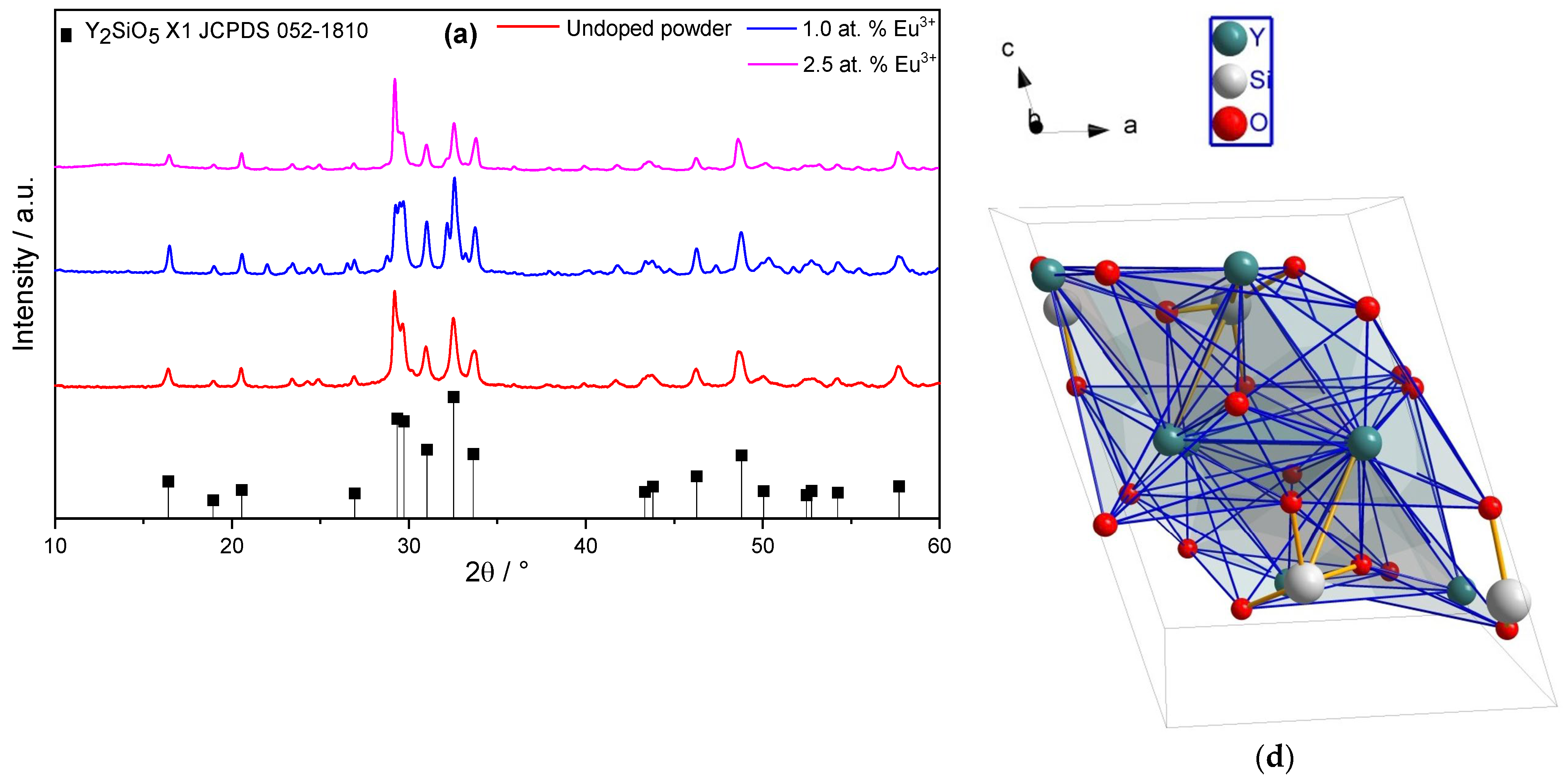
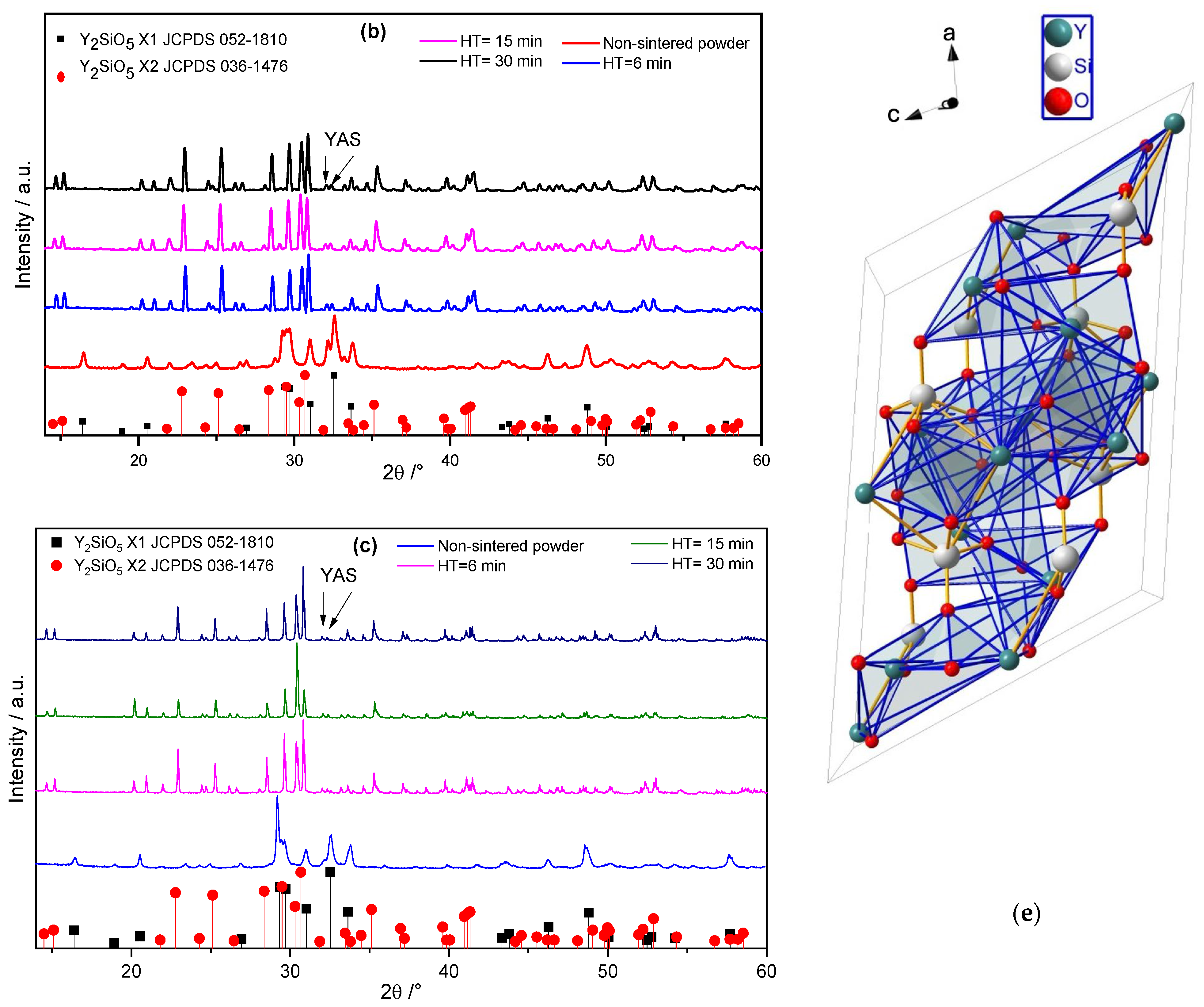
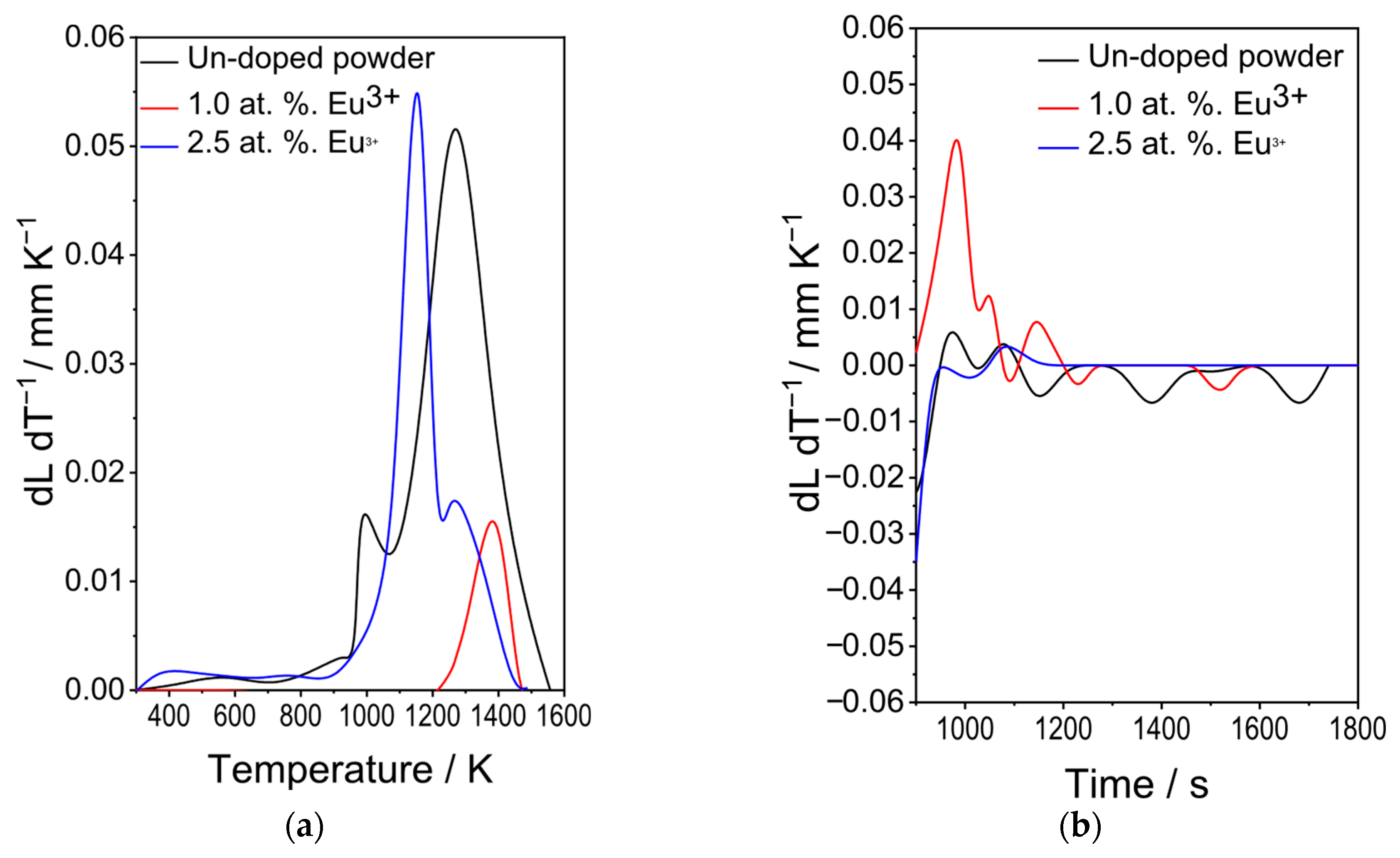

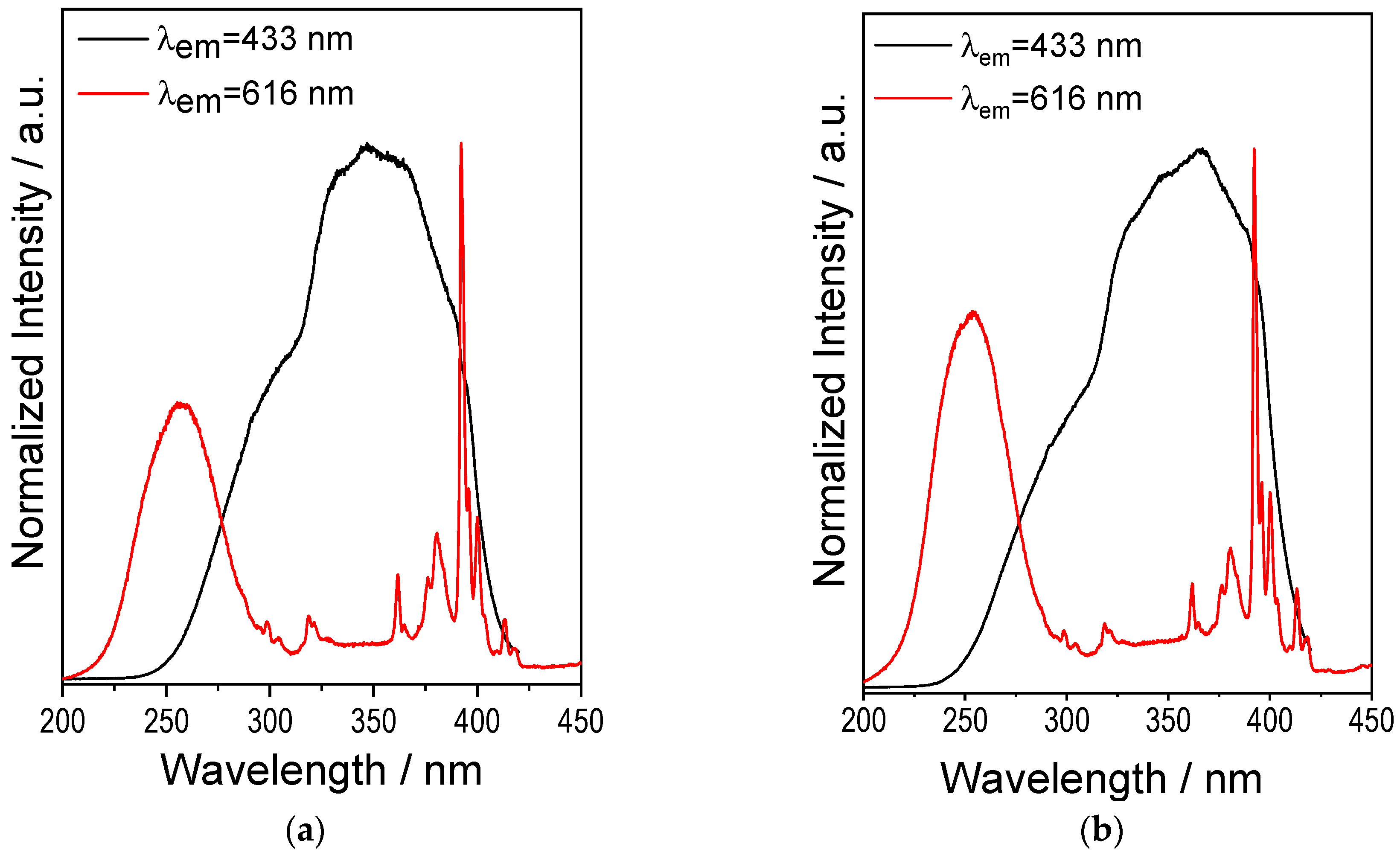
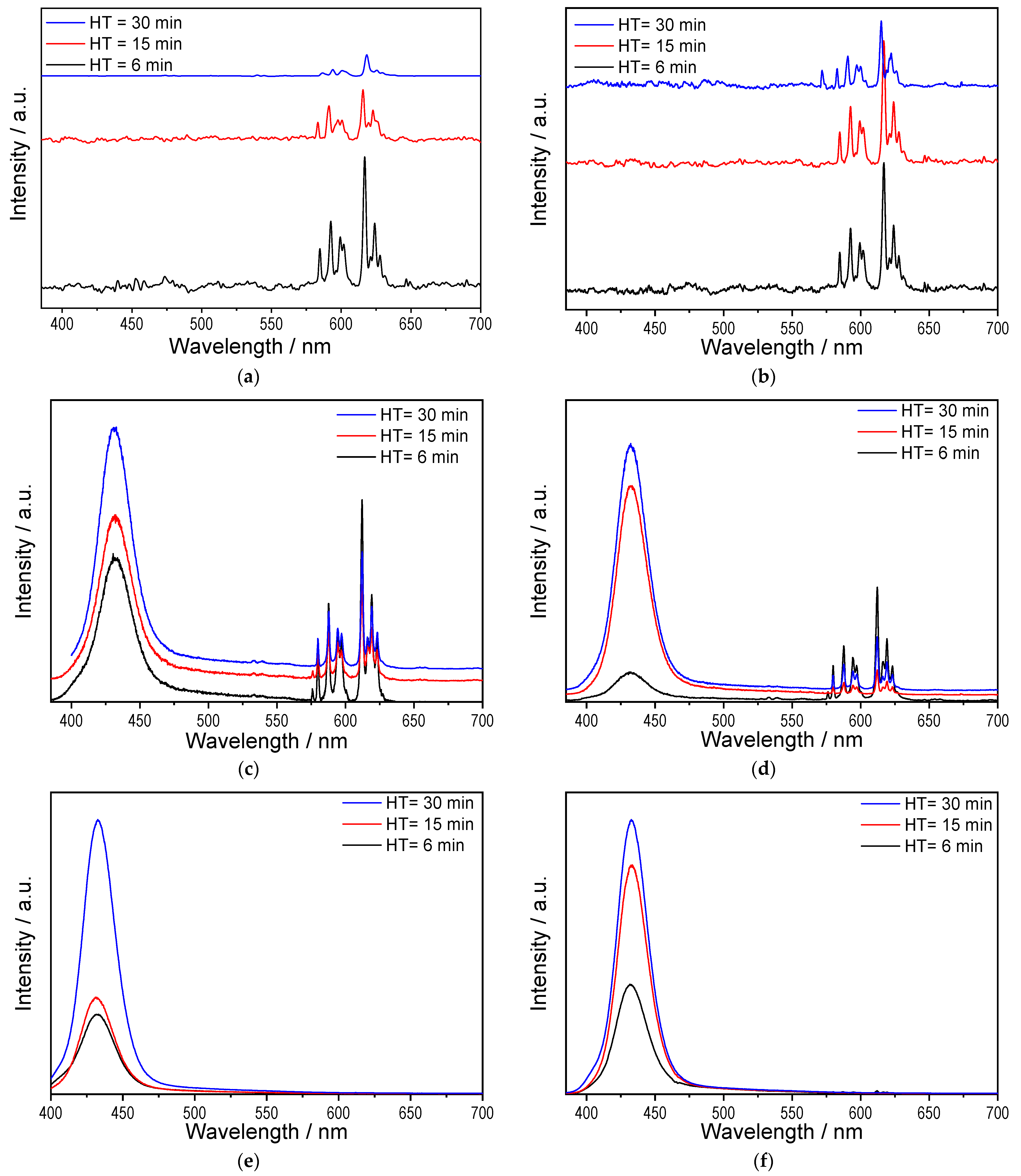
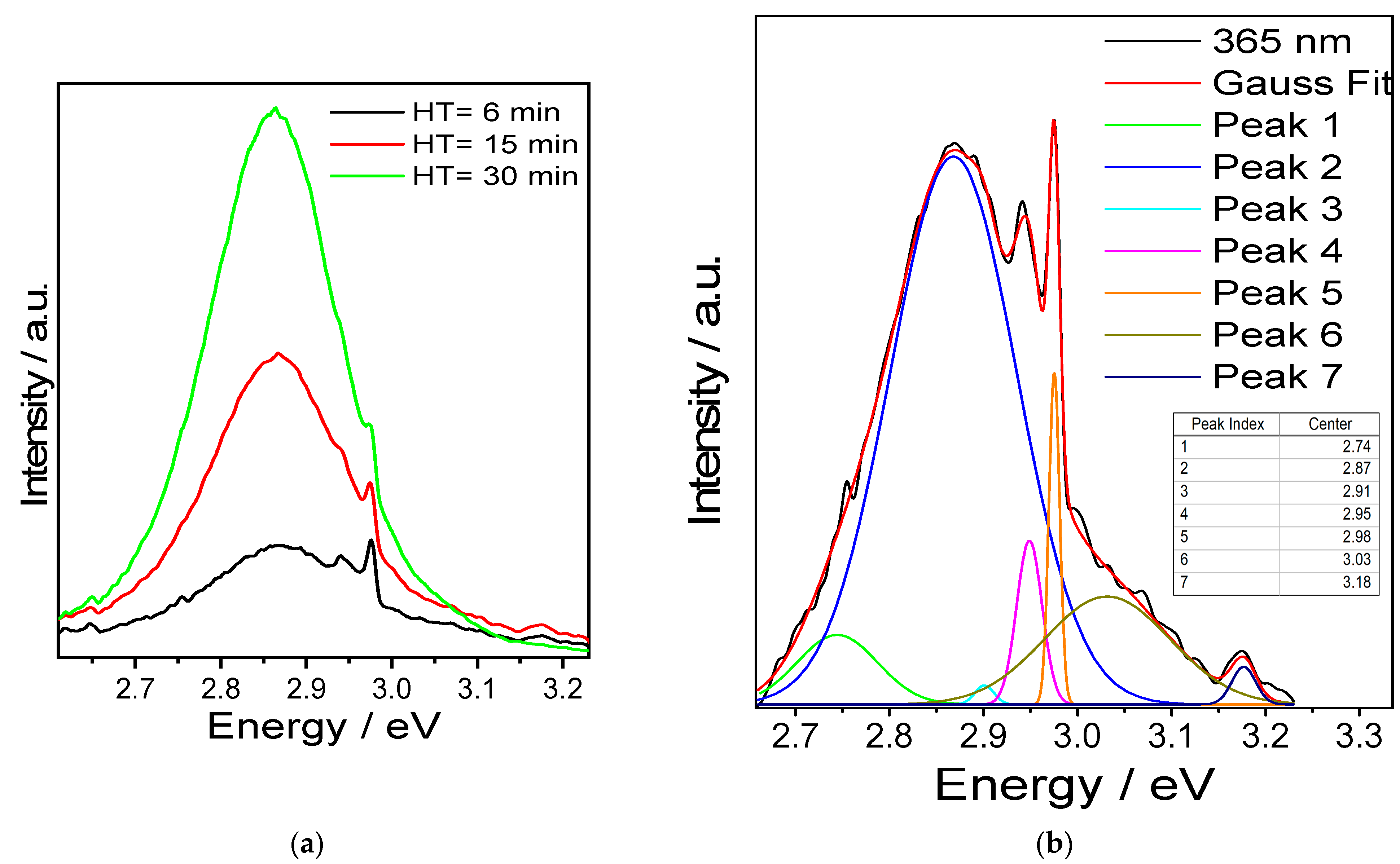


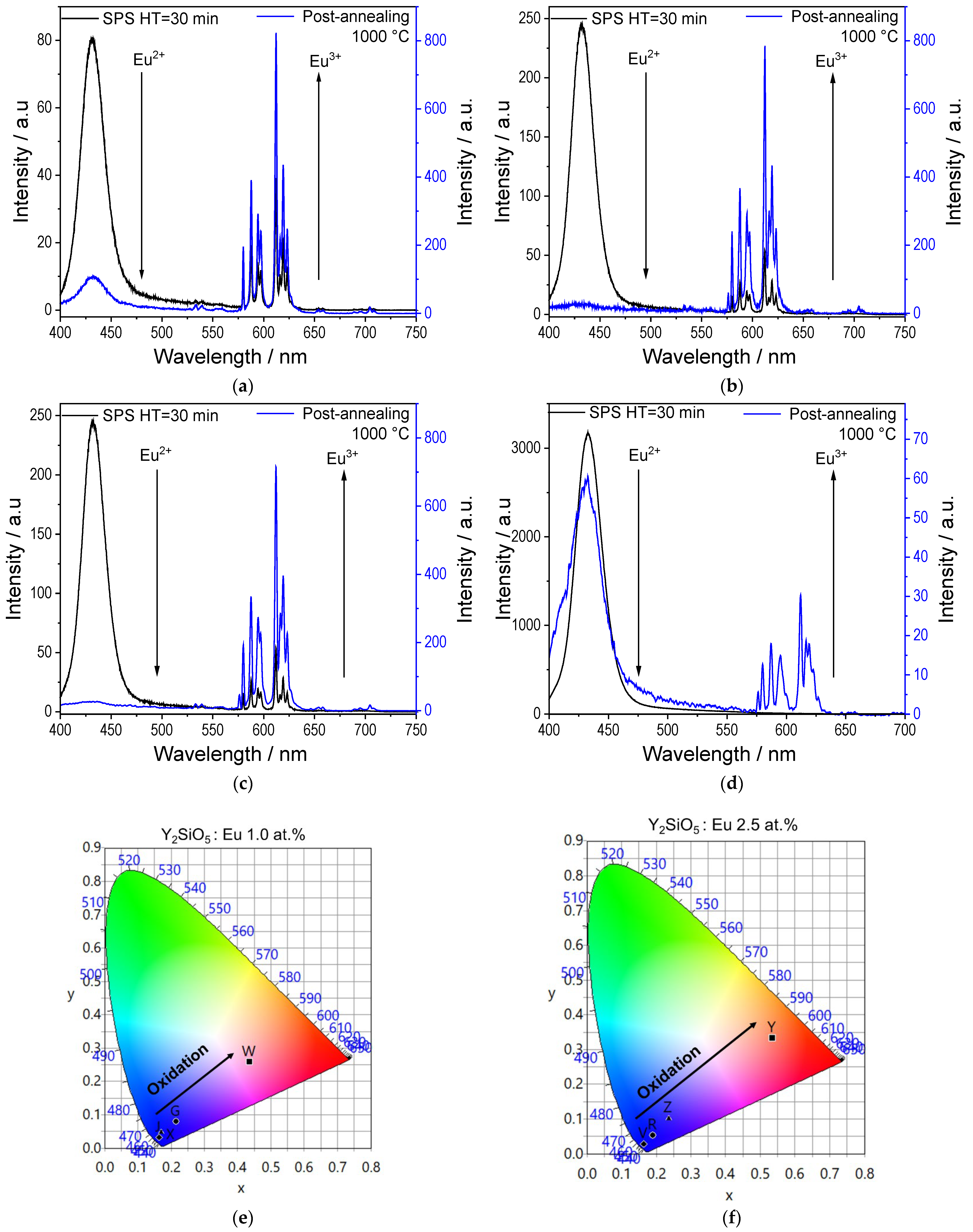
| Eu Content/at.% | HT/min | τ/ms | R2 |
|---|---|---|---|
| 1.0 | Powder | 1.4671 | 0.9988 |
| 6 | 1.6208 | 0.9994 | |
| 15 | 1.5853 | 0.9998 | |
| 30 | 1.5668 | 0.9992 | |
| 2.5 | Powder | 1.4588 | 0.9927 |
| 6 | 1.6486 | 0.9993 | |
| 15 | 1.6209 | 0.9995 | |
| 30 | 1.6014 | 0.9991 |
| Eu Content/at.% | HT/min | τ1/ms | τ2/ms | τavg/ms | R2 |
|---|---|---|---|---|---|
| 1.0 | 6 | 4.5584 | 0.8051 | 3.6565 | 0.9990 |
| 15 | 4.8472 | 0.8408 | 3.9083 | 0.9992 | |
| 30 | 0.9295 | 5.1183 | 4.1511 | 0.9988 | |
| 2.5 | 6 | 4.6949 | 0.8386 | 3.7508 | 0.9996 |
| 15 | 4.8048 | 0.8492 | 3.8658 | 0.9995 | |
| 30 | 0.7614 | 6.644 | 5.6114 | 0.9920 |
| Point | Eu Content/at.% | HT/min | λexc/nm | x | y | CCT/K | R | G | B | DW/nm | CP | HEX |
|---|---|---|---|---|---|---|---|---|---|---|---|---|
| A | 1.0 | 6 | 220 | 0.5846 | 0.3742 | 1414 | 255 | 91 | 0 | 598.4 | 87.8 | #FF5B00 |
| B | 15 | 0.5700 | 0.3492 | 1366 | 255 | 82 | 56 | 604.3 | 75.8 | #FF5238 | ||
| C | 30 | 0.5497 | 0.3357 | 1403 | 254 | 82 | 75 | 609.1 | 65.7 | #FE524B | ||
| D | Powder | 257 | 0.6007 | 0.3769 | 1348 | 254 | 86 | 0 | 598.4 | 93.4 | #FE5600 | |
| E | 6 | 0.2741 | 0.1131 | - | 208 | 0 | 255 | N/A | N/A | #D000FF | ||
| F | 15 | 0.2254 | 0.0918 | - | 157 | 0 | 255 | N/A | N/A | #9D00FF | ||
| G | 30 | 0.2148 | 0.0785 | - | 147 | 0 | 255 | N/A | N/A | #9300FF | ||
| H | Powder | 365 | 0.3303 | 0.2316 | - | 255 | 140 | 240 | N/A | N/A | #FF8CF0 | |
| I | 6 | 0.1646 | 0.0430 | - | 83 | 0 | 255 | 454.0 | 93.1 | #5300FF | ||
| J | 15 | 0.1645 | 0.0327 | - | 88 | 0 | 255 | 450.4 | 95.3 | #5800FF | ||
| K | 30 | 0.1649 | 0.0284 | - | 90 | 0 | 255 | 448.4 | 96.2 | #5A00FF | ||
| L | 2.5 | 6 | 220 | 0.6338 | 0.3472 | 1080 | 255 | 47 | 0 | 605.9 | 94.4 | #FF2F00 |
| M | 15 | 0.5886 | 0.3574 | 1314 | 255 | 79 | 35 | 602.4 | 83.9 | #FF4F23 | ||
| N | 30 | 0.5212 | 0.3211 | 1488 | 255 | 86 | 96 | 619.1 | 52.7 | #FF5660 | ||
| O | Powder | 257 | 0.6035 | 0.3646 | 1280 | 255 | 77 | 0 | 601.1 | 90.5 | #FF4D00 | |
| P | 6 | 0.3989 | 0.2277 | - | 255 | 78 | 184 | N/A | N/A | #FF4D00 | ||
| Q | 15 | 0.1786 | 0.0450 | - | 107 | 0 | 255 | 444.3 | 90.1 | #6B00FF | ||
| R | 30 | 0.1915 | 0.0529 | - | 123 | 0 | 255 | 431.2 | 86.0 | #7B00FF | ||
| S | Powder | 365 | 0.3608 | 0.2399 | - | 255 | 121 | 210 | N/A | N/A | #FF79D2 | |
| T | 6 | 0.1708 | 0.0535 | - | 90 | 0 | 255 | 454.0 | 89.8 | #5A00FF | ||
| U | 15 | 0.1648 | 0.0304 | - | 89 | 0 | 255 | 449.2 | 95.8 | #5900FF | ||
| V | 30 | 0.1649 | 0.0284 | - | 90 | 0 | 255 | 448.4 | 96.2 | #5A00FF |
| Point | Eu Content/at.% | HT/min | λexc/nm | x | y | CCT/K | R | G | B | DW/nm | CP | HEX |
|---|---|---|---|---|---|---|---|---|---|---|---|---|
| G | 1.0 | 30 | 257 | 0.2148 | 0.0785 | 147 | 0 | 255 | N/A | N/A | #9300FF | |
| W | Oxidised | 0.4363 | 0.2590 | 255 | 84 | 156 | N/A | N/A | #FF549C | |||
| J | 30 | 365 | 0.1645 | 0.0327 | 88 | 0 | 255 | 450.4 | 95.3 | #5800FF | ||
| X | Oxidised | 0.1711 | 0.0487 | 93 | 0 | 255 | 452.0 | 90.7 | #5D00FF | |||
| R | 2.5 | 30 | 257 | 0.1915 | 0.0529 | 123 | 0 | 255 | 431.2 | 86.0 | #7B00FF | |
| Y | Oxidised | 0.5359 | 0.3325 | 254 | 87 | 84 | 610.7 | 60.6 | #FE5754 | |||
| V | 30 | 365 | 0.1649 | 0.0284 | 1464 | 90 | 0 | 255 | 448.4 | 96.2 | #5A00FF | |
| Z | Oxidised | 0.2363 | 0.1018 | 168 | 0 | 255 | N/A | N/A | #A800FF |
Disclaimer/Publisher’s Note: The statements, opinions and data contained in all publications are solely those of the individual author(s) and contributor(s) and not of MDPI and/or the editor(s). MDPI and/or the editor(s) disclaim responsibility for any injury to people or property resulting from any ideas, methods, instructions or products referred to in the content. |
© 2025 by the authors. Licensee MDPI, Basel, Switzerland. This article is an open access article distributed under the terms and conditions of the Creative Commons Attribution (CC BY) license (https://creativecommons.org/licenses/by/4.0/).
Share and Cite
Juárez-López, F.; Navarro-Villanueva, M.A.; Cuamatzi-Meléndez, R.; García-Hernández, M.; Soto-Miranda, M.J.; Morales-Ramírez, A.d.J. Facile Reversible Eu2+/Eu3+ Redox in Y2SiO5 via Spark Plasma Sintering: Dwell Time-Dependent Luminescence Tuning. Inorganics 2025, 13, 325. https://doi.org/10.3390/inorganics13100325
Juárez-López F, Navarro-Villanueva MA, Cuamatzi-Meléndez R, García-Hernández M, Soto-Miranda MJ, Morales-Ramírez AdJ. Facile Reversible Eu2+/Eu3+ Redox in Y2SiO5 via Spark Plasma Sintering: Dwell Time-Dependent Luminescence Tuning. Inorganics. 2025; 13(10):325. https://doi.org/10.3390/inorganics13100325
Chicago/Turabian StyleJuárez-López, Fernando, Merlina Angélica Navarro-Villanueva, Rubén Cuamatzi-Meléndez, Margarita García-Hernández, María José Soto-Miranda, and Angel de Jesús Morales-Ramírez. 2025. "Facile Reversible Eu2+/Eu3+ Redox in Y2SiO5 via Spark Plasma Sintering: Dwell Time-Dependent Luminescence Tuning" Inorganics 13, no. 10: 325. https://doi.org/10.3390/inorganics13100325
APA StyleJuárez-López, F., Navarro-Villanueva, M. A., Cuamatzi-Meléndez, R., García-Hernández, M., Soto-Miranda, M. J., & Morales-Ramírez, A. d. J. (2025). Facile Reversible Eu2+/Eu3+ Redox in Y2SiO5 via Spark Plasma Sintering: Dwell Time-Dependent Luminescence Tuning. Inorganics, 13(10), 325. https://doi.org/10.3390/inorganics13100325







